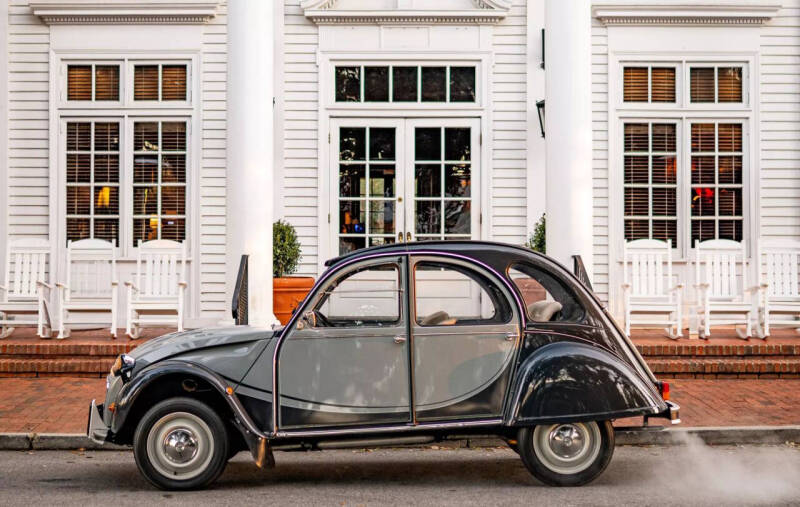 |
| 1986 Citroen 2CV6 |
|
Price: $29,980 |

Last Updated 8 hours ago
|
|
| Year: |
1986 |
| Make: |
Citroen |
| Model: |
2CV6 |
| Trim: |
N\A |
| Engine: |
600cc |
| Fuel: |
Gasoline |
| Color: |
Blue |
| Miles: |
61328 |
| Stock #: |
153585 |
| Body Style: |
N\A |
| Condition: |
Used |
 |
|
|
|
Vehicle Description
Experience the charm and quirkiness of driving a true automotive icon—the 1986 Citroën 2CV. Where vintage style meets endless fun behind the wheel!
When you think of iconic cars, the Citroën 2CV might not immediately come to mind, but this charmingly unique vehicle has earned its place in the automotive hall of fame. The 1986 Citroën 2CV example embodies the blend of innovative engineering and simplicity that helped to give the 2CV an undeniable character. From its quirky design to its surprisingly fun driving experience, the 2CV is a car that stands out in more ways than one!
Financing Available! Apply Directly at our lending partner Woodside Credit . Contact us for additional lenders and financing options. Also, we have no dealer or doc fees! Each vehicle go through a review in our shop before being listed for sale. Contact us to review the full-service work completed. We can customize and service your vehicle, from upgraded performance features, air conditioning, and personalized interiors, we turn dreams into reality. Drive a vehicle that's uniquely yours – discover the limitless possibilities with Car Cave.
Highlights
Fantastic condition and ready to drive
The best color combo
Iconic automobile that's an entertaining driving experience in and of itself!
Oh and it was a James Bond car!
The 2CV was designed in the 1930s to mobilize France's rural population. It was built with simplicity and practicality at its core, aimed at replacing horse-drawn carts with a reliable, low-cost vehicle. This 1986 model represents the culmination of nearly 40 years of doing just that. The car's original design brief was simple: Inexpensive, easy to maintain, and fuel efficient. The result was a car that combined innovative engineering with utilitarian bodywork.
This 2CV6 is powered by a 602 cc air-cooled engine that delivers 29 hp, providing just enough pep to make city driving a breeze. For the daring driver a claimed top speed of 71 mph is an interesting target. While its acceleration is not exactly thrilling—it’s often joked that the 2CV goes 'from 0 to 60 one day'
Power and performance might not be its strong suit, but reliability and efficiency certainly are!
The 2CV engine was renowned for its exceptional reliability, with test engines being run at full speed for 1,000 hours straight—equivalent to driving 80,000 km (50,000 miles) at full throttle.
The engine's design focused on minimizing moving parts for greater reliability. The cooling fan and dynamo were integrated directly into the one-piece crankshaft, eliminating the need for drive belts except for the alternator. Gaskets, often a source of potential failure and leaks, are used sparingly. Instead, cylinder heads are joined to the barrels with lapped joints that featured extremely fine tolerances, as are the two halves of the crankcase and other surface-to-surface connections.
The engine's minimal use of gaskets is further supported by a unique crankcase ventilation system. In a 2-cylinder boxer engine like the 2CV's, the crankcase volume changes with the pistons' movement, leading to a positive pressure that needs to be managed to prevent inefficiencies and leaks. The 2CV engine featured a combined breather and oil filler assembly with rubber reed valves. These valves allowed excess pressure to escape into the engine's air intake for recirculation while closing as the pressure dropped, creating a slight vacuum. This vacuum ensured that any weak seals will draw in air rather than allow oil to leak out, maintaining the engine's efficiency and reliability.
Additionally, if the starter motor or battery fails, the 2CV has the option of hand-cranking. The jack handle could be used as a starting handle by attaching it to the front of the crankshaft, near the fan. This feature, was still prevalent in 1948 when the 2CV was introduced, remained a part of the car's design until production ended in 1990.
The 2CV’s has |
|
|
|
|
|